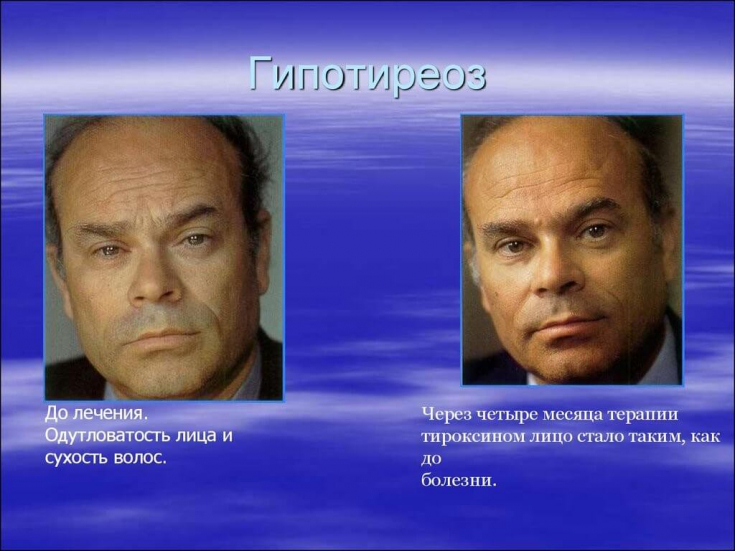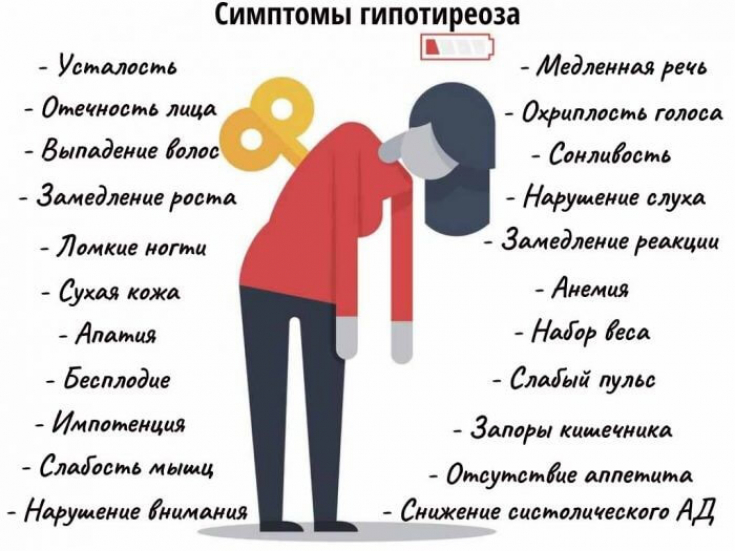The most common form of thyroid dysfunction is the development of hypothyroidism.
Hypothyroidism − This is a syndrome characterized by complete or partial dysfunction of the thyroid gland, absolute or relative deficiency of thyroid hormones and is manifested by functional and organic changes in target organs. There are primary, secondary, tertiary and peripheral hypothyroidism.
Find out in the article on estet-portal.com what complications can occur if hypothyroidism is not treated.
- Clinical classification of hypothyroidism
- Complications and symptoms of hypothyroidism
- Basic approaches to the treatment of hypothyroidismfor
Clinical classification of hypothyroidism
The most common (99%) primary hypothyroidism occurs due to direct damage to the thyroid gland, therefore, unless otherwise indicated, under the term "hypothyroidism" understand primary hypothyroidism.
In primary hypothyroidism, thyroid-stimulating hormone (TSH) levels are elevated and thyroxine levels are reduced (overt hypothyroidism) or TSH is elevated in isolation.
Follow us on Instagram!
Secondary hypothyroidism develops with a decrease in the thyroid-stimulating function of the pituitary gland, with tertiary hypothyroidism pathology of the hypothalamus takes place; peripheral hypothyroidism is caused by impaired receptor perception of thyroid hormones.
What metabolic and hormonal disorders develop in obesity
A characteristic feature of hypothyroidism is gradual, very slow development and blurred clinical picture. For a long time, patients may not notice the ongoing changes and may not seek medical attention.
In addition, a number of symptoms from other organs (nervous, cardiovascular of that system, hematopoietic system and others) come to the fore, which the patient does not associate with damage to the thyroid glands.
Complications and symptoms of hypothyroidism
- Hypertension
Increased blood pressure (BP) is determined in more than 30-50% of patients with hypothyroidism, often it is one of the first clinical manifestations of the disease.
In patients with hypothyroidism, increased central arterial tone and higher central blood pressure are determined. A characteristic feature of arterial hypertension in hypothyroidism is initial and predominant increase in diastolic blood pressure.
Some clinicians even suggest assessing the severity of hypothyroidism by the level of increase in diastolic BP.
- Irregular heart rhythm
The most typical variant of cardiac arrhythmia in hypothyroidism is sinus bradycardia, which is observed in the vast majority of patients and is combined with the absence of a noticeable change in heart rate in various physical and psycho-emotional states.
Bradycardia can be quite expressive and reach 30-40 heartbeats per minute. The degree of bradycardia is one of the criteria for the severity of hypothyroidism.
The reasons for the development of bradycardia are both a decrease in the content of catecholamines in the blood and the sensitivity of the adrenoreceptors of the heart to them, and the adaptation of the heart to a reduced basal metabolism. Quite often, with severe hypothyroidism and bradycardia, blockade.

- Dyslipidemia
Dyslipidemia is one of the most studied cardiovascular complications of hypothyroidism. Due to a deficiency of thyroid hormones, both the synthesis and degradation of lipids are impaired.
The authors concluded that hypothyroidism is a more significant CV risk factor than diabetes mellitus, smoking, dyslipidemia, or hypertension.
Prediabetes: how to identify a dangerous condition and prevent diabetes
The clinical picture of hypothyroidism is characterized by changes in most organs and systems. Already during a general examination, the patient's lethargy, apathy, slow speech, low rough voice (due to swelling of the vocal cords) attract attention.
The skin is dry, pale, pale icteric, cold, with massive hyperkeratosis, especially on the elbows and heels; hair is brittle and dull.

Definitively confirms the diagnosis − determination of the level of hormones in the blood. To screen for hypothyroidism, it is usually not necessary to determine all the hormones associated with thyroid function.
The most diagnostic significance is the determination of the level of TSH, if necessary, the level of thyroxine is determined by the indicationspits.
Basic approaches to the treatment of hypothyroidism
Treatment of patients with hypothyroidism must necessarily include replacement therapy with thyroid hormone preparations. Regardless of the form of hypothyroidism − primary, secondary, or tertiary, it is common to prescribe thyroid drugs directly.
The most physiological is the appointment of L-thyroxine at the rate of 1.5-1.8 µg/kg per day. Therapy is recommended to start with the minimum doses of − 25 micrograms per day for middle-aged people and 12.5 micrograms per day for older people with severe dystrophic changes in the myocardium.
In the future, the dose is increased weekly, bringing it to an adequate replacement. Control of the adequacy of replacement therapy for hypothyroidism is usually carried out by the level of blood TSH.
Follow the latest news in the world of aesthetic medicine on our YouTube channel!







Add a comment